
table of contents
- care
- Location
- plants
- to water
- Fertilize
- Cut
- Multiply
- Diseases
- sorts
Profile and care information open +conclude -
- Flower color
- pink, purple, green, blue
- Location
- Sunny
- Heyday
- April May
- Growth habit
- upright, spreading, bushy
- height
- up to 10 meters high
- Soil type
- sandy, loamy
- Soil moisture
- moderately dry
- PH value
- neutral, weakly alkaline
- Limescale tolerance
- Calcium tolerant
- humus
- k. A.
- Poisonous
- Yes
- Plant families
- Legumes, Fabaceae
- Plant species
- Ornamental trees
- Garden style
- Ornamental garden, forest garden
The Judas tree is one of the most extraordinary ornamental trees and not only an absolute eye-catcher when it blooms. The special thing about this plant is its stem bloom, which is otherwise only known from tropical plants. In spring there are countless purple-pink flowers on the trunk, branches and twigs. The blue-green or purple-colored, in autumn yellowish, heart-shaped foliage that appears after flowering is no less attractive. This fascinating flowering wood grows as a large shrub, small tree or high trunk.
care
With its overwhelming abundance of flowers and the contrasting foliage, this wood is the perfect complement to ornamental cherry and magnolia. Its fascinating flowering properties make it an excellent specimen plant. It is quite undemanding to maintain. Nevertheless, care mistakes or unfavorable site conditions can lead to the flower not being bloomed.
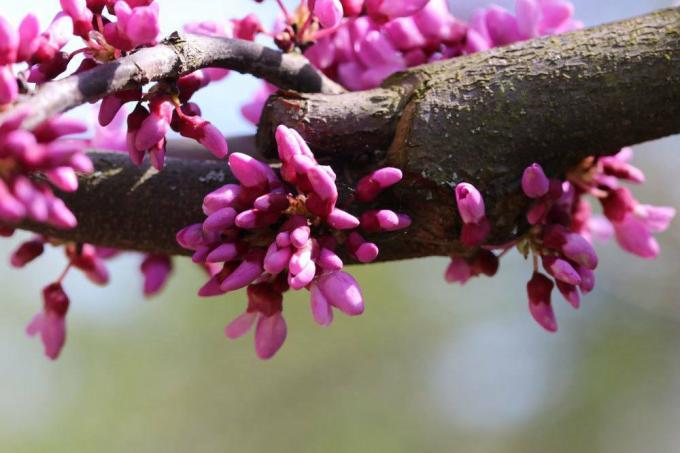
Location
When looking for the best planting site, one should bear in mind that the Judas tree can take on considerable dimensions in the area of the crown and roots and accordingly requires a lot of space. Its ultimate height should also be taken into account. Cercis canadensis prefers a warm, sunny and sheltered spot, preferably facing south. He also wants to be warm and sunny in the bucket, ideally on a south-facing balcony or a south-facing terrace.
Tip: If this plant finds optimal location conditions, it can form meter-long root runners and, if necessary, lift paving stones from neighboring terraces or sidewalks.
floor
The Canadian Judas tree forms relatively strong, deep-reaching main roots but only a few lateral and fine roots. It can develop particularly well in sandy, well-drained loamy soils. Ideally, the soil is calcareous, moderately rich in nutrients and rather dry and neutral to slightly alkaline. Basically, the Judas tree thrives in any good garden soil. Pure loam soils and slightly acidic to acidic soils are completely unsuitable.
plants
Planting in the garden
- Planting time in spring and autumn
- Preferably plant young specimens in spring
- Plants from the age of three can also tolerate autumn planting
- water the root ball before planting
- meanwhile dig a planting hole
- that should be at least twice the size of the root ball
- If necessary, improve the soil in the planting hole by adding sand
- Plant the Judas tree as deep as it was in the pot before
- then fill up with excavated earth and water
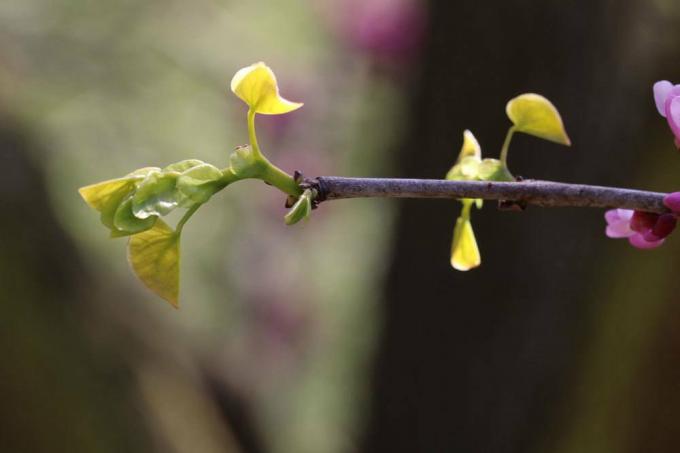
Tip: Initially, it can be useful to attach the plant to a support to ensure that it grows straight.
Planting in the bucket
Smaller varieties such as B. 'Hearts of Gold'. A sufficiently large planter with appropriate drainage holes and drainage on the bottom of the pot should be ensured here. This is to avoid waterlogging, to which the Judas tree would react very sensitively. Here, too, spring is the ideal time to plant.
When the planter is deeply rooted, it's time to repot it in a larger container. The new pot should not be more than 3 - 5 cm larger in diameter than the old one. When it comes to the substrate, you can use commercially available potted plant soil, the storage capacity and permeability of which is achieved by the addition of coarse-grained fractions such as. B. Gravel, lava gravel or expanded clay can improve. After planting, press the soil down and water it.
to water
Specimens planted in the garden usually do not have to be watered at all or only rarely. Normally, the natural amounts of rain are sufficient. Even longer periods of heat and drought are no problem for this plant. Too much moisture should be avoided at all costs, otherwise this would negatively affect the formation of flowers. Container plants, on the other hand, should be watered regularly, but here too, excessive watering should be avoided.
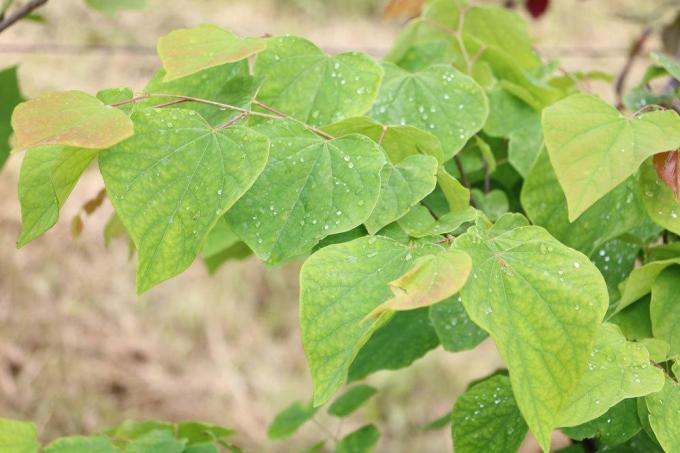
Fertilize
Similar to watering, the Judas tree Cercis canadensis does not need any additional fertilizers in the garden. Most legumes, including the Judas tree, naturally enter into a symbiosis with nitrogen-fixing bacteria. You practically supply yourself with sufficient nitrogen, regardless of the nitrate content in the soil. Only in the bucket can a highly diluted complete fertilizer be administered during the growth phase.
Cut
Cercis canadensis should be cut as little as possible, even if it is actually very easy to cut. Only if a certain growth habit is to be achieved, such as a high trunk, a shrub shape or as a bonsai, a more pronounced pruning can also be made.
- only a care cut is recommended
- the best time to do this is in spring
- Cut just before the buds break
- Cut out dead and diseased parts
- Remove branches and twigs with frost damage
- Cut away inward growing shoots that compete with the main stem
Tip: With older plants that have not been cut for a long time, the additional thinning of the crown can be useful, but you should limit yourself to the bare essentials. When raised as a shrub, some of the shoots can be shortened by a third.
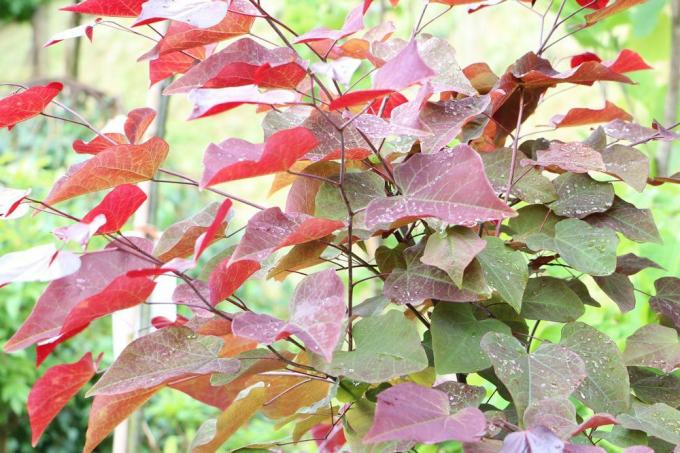
Raise high trunk
The trunk of young plants is not yet so pronounced and only develops over the years, it must be tied up. To do this, the strongest shoot is selected as the main shoot, from which the trunk will later develop. This lead drive is loosely attached to a supporting rod. The height of the support should be the final height of the tree. The lower side shoots must be removed regularly. A pruning for upbringing as a standard trunk should be done in spring, in mild and cloudy weather as possible.
Hanging Judas tree - cut
Hanging Judas trees are a rather rare sight. The branches, which hang down in a cascade shape, are adorned with brightly colored flowers and set effective accents. Even if pruning measures are well tolerated, species that grow hanging should only be pruned for maintenance purposes, if possible, in order to preserve their unusual habit. This care is limited to removing dead, damaged or annoying branches. The overhanging side branches can be shortened if necessary or completely removed in the lower area.
Pruning the bonsai judas tree
Specimens grown as bonsai need regular pruning in order to achieve and maintain this special shape. Ideally, the new shoots should be cut back to 2 - 3 pairs of leaves after flowering. The same is done with new shoots that develop in the current year. Shoots that are not needed can be removed directly at the base.
Overwinter
Of the 11 known species of the Judas tree, the Canadian (Cercis canadensis), the common one (Cercis siliquastrum) and the Chinese Judas tree (Cercis chinensis) as ornamental trees held. The winter hardiness of this attractive flowering wood depends on the species, which you should consider when buying a plant. The Canadian Judas tree is considered to be the hardiest species. Nevertheless, neither Cercis siliquastrum and Cercis chinensis nor Cercis canadensis are actually fully hardy, especially not in particularly cold locations.
- only in old age is there a certain insensitivity
- young and newly planted trees need winter protection
- cover the root area with a layer of leaves, brushwood or straw
- Protect the trunk and branches with a fleece and remove them again in March
- Fleece also protects buds and flowers from late frosts, if they are already formed
- it should be permeable to air to prevent rot and fungal attack
- older specimens of this type usually do not need any additional protection
Judas trees in the bucket are more vulnerable to frost. In rather mild regions, it is sufficient to pack the bucket well. You wrap it with bast mats or bubble wrap and fill the gaps with dry leaves, which can also be used to cover the root area. A raised stand on a styrofoam plate or a wooden pallet also protects the root area from freezing.
Tip:Bark mulch should not be used as a cover, it will acidic the soil.
Multiply
Seeds
Seeds for propagation can be collected from the withered legumes in the fall. Since they are only slightly poisonous, protective measures can be dispensed with. The ripe seeds should be sown as fresh as possible; storage in the meantime will impair the ability to germinate. A cold frame is very suitable. Here, higher temperatures are reached quickly and there is a certain protection against late frosts. The seeds can also be sown directly in the garden or in pots that are left outside for the winter, because the seeds need frost to germinate.
- from March / April can also be sown indoors
- here the seeds have to be pre-treated
- Put seeds in a plastic bag in the refrigerator for 5-6 days
- then soak in lukewarm water for 24 hours
- then sow about 1 cm deep in a moderately moist growing medium
- preferably use low-nutrient coconut fiber
- or commercial potting soil mixed with sand or perlite
- Cover the seed pot with translucent film or glass
- Place in a bright place with temperatures of 22-25 degrees
- it can take 2-4 weeks for germination
- Keep the substrate constantly moist
- Separate seedlings from a size of 10 cm

Tip: If the seeds are sown in the garden, the seeds should be protected from being eaten by mice with a fine-meshed screen.
Cuttings
For propagation by cuttings, cuttings 10-15 cm long are cut from the mother plant in summer. The cut should be made at an angle and, if possible, only be made with a sterile cutting tool. Any leaves at the bottom are removed and any remaining leaves cut in half to keep evaporation as low as possible.
Then you insert it approx. 5 cm deep in small pots with potting soil. A rooting agent can, if necessary, promote the formation of roots. The substrate is moistened, the cutting is covered with cling film and the pots are placed in a bright and warm place without direct sunlight. If the rooting was successful, this is shown by a new shoot. However, this can take several weeks or even months.
Tip: Even if Cercis canadensis can theoretically be propagated from seeds and cuttings, both methods are rarely successful.
Diseases
Verticillium wilt
Verticillium wilt is a disease caused by fungi. It manifests itself in initially one-sided wilt and the tree does not bloom. To determine whether it is infected, scrape off the bark on infected shoots or near the ground, so that you can see whether the water pipes underneath have a brown discoloration exhibit. If this is the case, one can assume that it is the Verticillium wilt and that the plant can usually no longer be saved.
It must be completely removed and disposed of. Since the verticillium wilt pathogens can sometimes survive in the soil for many years, the soil in this area should be replaced and destroyed over a large area. In addition, similarly susceptible plants should not be planted in this location. In order not to buy plants that are already sick, they should be checked carefully for possible damage. It is best to buy them from a nursery.
Heart tree does not bloom
Hobby gardeners who own such a rarity often complain that the Judas tree does not flower. This can have several causes. It does not bloom if there is a pest infestation or a fungal disease. Also draughty and too dark locations or acidic soil can be the trigger for a failure to bloom, as well as frostbite of buds and flowers caused by late frosts. Mistakes are often made when fertilizing, especially with nitrogenous fertilizers. These should be avoided completely, as the Judas tree can supply itself with sufficient nitrogen.
sorts
One variety more beautiful than the other
The Judas tree is one of the most beautiful and rarest ornamental trees in German gardens, both as a shrub and as a small tree. Its extraordinary flowering behavior, the so-called stem bloom, is typical of all types of the Judas tree. As with Cercis siliquastrum and Cercis chinensis, the varieties of Cercis canadensis are visual highlights in every garden.
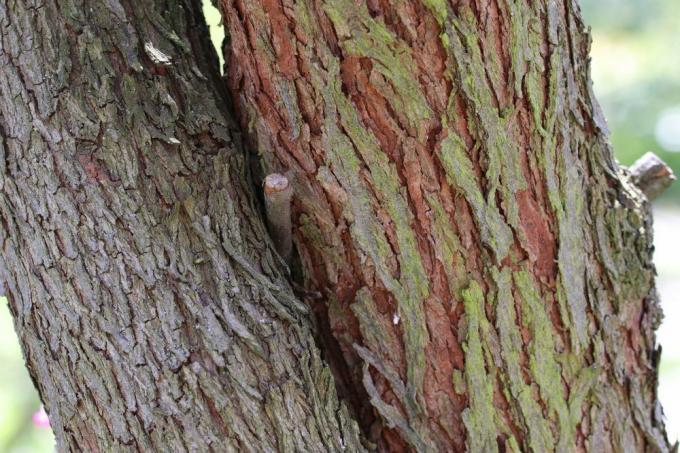
'Forest Pansy' - Red Judas Tree
- In addition to a magnificent abundance of flowers, this variety scores with blood-red shoots and red foliage, which become darker over the course of the year and take on a yellowish-reddish color in autumn
- parts that are in a shady way merge into the green
- it reaches heights of 3 - 4 m
- Fruits and seeds are slightly poisonous
'Hearts of Gold' - Gold Judas Tree
- This new breed from the USA impresses in spring with light purple butterfly flowers and later golden yellow foliage
- it grows 3 - 4 m in height and 2 - 2.5 m in width
'Lavender Twist' - hanging Judas tree
- What is special about this medium-sized shrub or small tree, in addition to the rich flowering, are the drooping shoots
- the heart-shaped foliage is medium green
'Ruby Falls' - Red hanging Judas tree
- the branches of 'Ruby Falls' grow arching overhanging and sometimes reach to the ground
- the foliage is shiny dark red and can turn green in shady locations
- here too, as with all varieties, fruits and seeds are slightly poisonous
